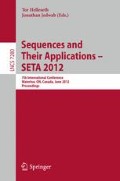Abstract
Differentially 4-uniform permutations over \({\mathbb F}_{2^{2k}}\), especially those with high nonlinearity and high algebraic degree, are cryptographically significant mappings as they are good choices for the substitution boxes (S-boxes) in many symmetric ciphers. For instance, the currently endorsed Advanced Encryption Standard (AES) uses the inverse function, which is a differentially 4-uniform permutation. However, up to now, there are only five known infinite families of such mappings which attain the known maximal nonlinearity. Most of these five families have small algebraic degrees and only one family can be defined over \({\mathbb F}_{2^{2k}}\) for any positive integer k. In this paper, we apply the powerful switching method on the five known families to construct differentially 4-uniform permutations. New infinite families of such permutations are discovered from the inverse function, and some sporadic examples are found from the others by using a computer. All newly found infinite families can be defined over fields \({\mathbb F}_{2^{2k}}\) for any k and their algebraic degrees are 2k − 1. Furthermore, we obtain a lower bound for the nonlinearity of one infinite family.
Access this chapter
Tax calculation will be finalised at checkout
Purchases are for personal use only
Preview
Unable to display preview. Download preview PDF.
References
Biham, E., Shamir, A.: Differential cryptanalysis of DES-like cryptosystems. Journal of Cryptology 4(1), 3–72 (1991)
Budaghyan, L., Carlet, C., Leander, G.: Constructing new APN functions from known ones. Finite Fields and Their Applications 15(2), 150–159 (2009)
Bracken, C., Tan, C.H., Tan, Y.: Binomial differentially 4-uniform permutations with high nonlinearity. Finite Fields and Their Applications 18(3), 537–546 (2012)
Carlet, C.: On Known and New Differentially Uniform Functions. In: Parampalli, U., Hawkes, P. (eds.) ACISP 2011. LNCS, vol. 6812, pp. 1–15. Springer, Heidelberg (2011)
Charpin, P., Kyureghyan, G.M.: On a Class of Permutation Polynomials over \(\mathbb{F}_{2^n}\). In: Golomb, S.W., Parker, M.G., Pott, A., Winterhof, A. (eds.) SETA 2008. LNCS, vol. 5203, pp. 368–376. Springer, Heidelberg (2008)
Charpin, P., Kyureghyan, G.M.: When does G(x) + γTr(H(x)) permute \({\mathbb F}_{p^n}\). Finite Fields and Their Applications 15(2), 615–632 (2009)
Dillon, J.F.: APN polynomials: an update. In: Conference Finite Fields and Applications, Fq9, Dublin, Ireland (2009)
Dubuc, S.: Characterization of linear structures. Desings, Codes and Cryptography 22, 33–45 (2001)
Edel, Y., Pott, A.: A new almost perfect nonlinear function which is not quadratic. Advances in Mathematical Communications 3(1), 59–81 (2009)
Knudsen, L.: Truncated and Higher Order Differentials. In: Preneel, B. (ed.) FSE 1994. LNCS, vol. 1008, pp. 196–211. Springer, Heidelberg (1995)
Lachaud, G., Wolfmann, J.: The weights of the orthogonals of the extended quadratic binary Goppa codes. IEEE Transaction on Information Theory 36(3), 686–692 (1990)
Lai, X.: Additivie and Linear Structures of Cryptographic Functions. In: Preneel, B. (ed.) FSE 1994. LNCS, vol. 1008, pp. 75–85. Springer, Heidelberg (1995)
Laigle-Chapuy, Y.: A Note on a Class of Quadratic Permutations over \(\mathbb{F}_{2^n}\). In: Boztaş, S., Lu, H.-F(F.) (eds.) AAECC 2007. LNCS, vol. 4851, pp. 130–137. Springer, Heidelberg (2007)
Lidl, R., Niederreiter, H.: Finite Fields. Encyclopedia of Mathematics and its Applications, vol. 20 (1997)
Matsui, M.: Linear Cryptanalysis Method for DES Cipher. In: Helleseth, T. (ed.) EUROCRYPT 1993. LNCS, vol. 765, pp. 386–397. Springer, Heidelberg (1994)
Stichtenoth, H.: Algebraic function fields and codes (Springer Universitext). Springer, Berlin (1993)
Author information
Authors and Affiliations
Editor information
Editors and Affiliations
Rights and permissions
Copyright information
© 2012 Springer-Verlag Berlin Heidelberg
About this paper
Cite this paper
Tan, Y., Qu, L., Tan, C.H., Li, C. (2012). New Families of Differentially 4-Uniform Permutations over \({\mathbb F}_{2^{2k}}\) . In: Helleseth, T., Jedwab, J. (eds) Sequences and Their Applications – SETA 2012. SETA 2012. Lecture Notes in Computer Science, vol 7280. Springer, Berlin, Heidelberg. https://doi.org/10.1007/978-3-642-30615-0_3
Download citation
DOI: https://doi.org/10.1007/978-3-642-30615-0_3
Publisher Name: Springer, Berlin, Heidelberg
Print ISBN: 978-3-642-30614-3
Online ISBN: 978-3-642-30615-0
eBook Packages: Computer ScienceComputer Science (R0)

